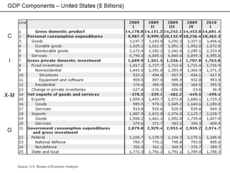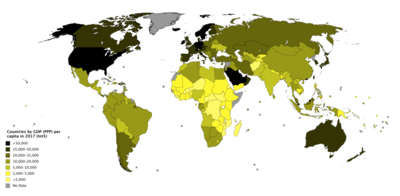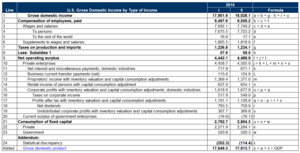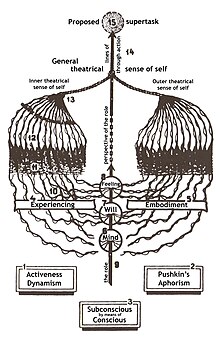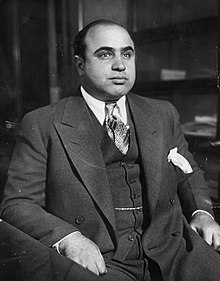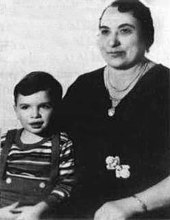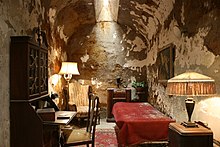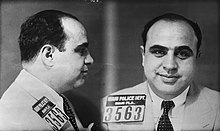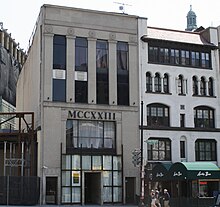A map of world economies by size of GDP (nominal) in USD, World Bank, 2014
Gross domestic product (GDP) is a monetary measure of the market value of all the final goods and services produced in a specific time period.
GDP (nominal) per capita does not, however, reflect differences in the cost of living and the inflation rates of the countries; therefore using a basis of GDP per capita at purchasing power parity (PPP) is arguably more useful when comparing living standards between nations, while nominal GDP is more useful comparing national economies on the international market.
The OECD defines GDP as "an aggregate measure of production equal to the sum of the gross values added
of all resident and institutional units engaged in production and
services (plus any taxes, and minus any subsidies, on products not
included in the value of their outputs)." An IMF
publication states that, "GDP measures the monetary value of final
goods and services—that are bought by the final user—produced in a
country in a given period of time (say a quarter or a year)."
Total GDP can also be broken down into the contribution of each industry or sector of the economy. The ratio of GDP to the total population of the region is the per capita GDP
and the same is called Mean Standard of Living. GDP is considered the
"world's most powerful statistical indicator of national development and
progress".
History
William Petty came up with a basic concept of GDP to attack landlords against unfair taxation during warfare between the Dutch and the English between 1654 and 1676. Charles Davenant developed the method further in 1695. The modern concept of GDP was first developed by Simon Kuznets for a US Congress report in 1934. In this report, Kuznets warned against its use as a measure of welfare (see below under limitations and criticisms). After the Bretton Woods conference in 1944, GDP became the main tool for measuring a country's economy. At that time gross national product
(GNP) was the preferred estimate, which differed from GDP in that it
measured production by a country's citizens at home and abroad rather
than its 'resident institutional units' (see OECD
definition above). The switch from GNP to GDP in the US was in 1991,
trailing behind most other nations. The role that measurements of GDP
played in World War II was crucial to the subsequent political
acceptance of GDP values as indicators of national development and
progress. A crucial role was played here by the US Department of Commerce under Milton Gilbert where ideas from Kuznets were embedded into institutions.
The history of the concept of GDP should be distinguished from
the history of changes in ways of estimating it. The value added by
firms is relatively easy to calculate from their accounts, but the value
added by the public sector, by financial industries, and by intangible asset
creation is more complex. These activities are increasingly important
in developed economies, and the international conventions governing
their estimation and their inclusion or exclusion in GDP regularly
change in an attempt to keep up with industrial advances. In the words
of one academic economist "The actual number for GDP is therefore the
product of a vast patchwork of statistics and a complicated set of
processes carried out on the raw data to fit them to the conceptual
framework."
Determining gross domestic product (GDP)
An infographic explaining how GDP is calculated in the UK
GDP can be determined in three ways, all of which should,
theoretically, give the same result. They are the production (or output
or value added) approach, the income approach, or the speculated
expenditure approach.
The most direct of the three is the production approach, which
sums the outputs of every class of enterprise to arrive at the total.
The expenditure approach works on the principle that all of the product
must be bought by somebody, therefore the value of the total product
must be equal to people's total expenditures in buying things. The
income approach works on the principle that the incomes of the
productive factors ("producers," colloquially) must be equal to the
value of their product, and determines GDP by finding the sum of all
producers' incomes.
Production approach
This approach mirrors the OECD definition given above.
- Estimate the gross value of domestic output out of the many various economic activities;
- Determine the intermediate consumption, i.e., the cost of material, supplies and services used to produce final goods or services.
- Deduct intermediate consumption from gross value to obtain the gross value added.
Gross value added = gross value of output – value of intermediate consumption.
Value of output = value of the total sales of goods and services plus value of changes in the inventory.
The sum of the gross value added in the various economic activities is known as "GDP at factor cost".
GDP at factor cost plus indirect taxes less subsidies on products = "GDP at producer price".
For measuring output of domestic product, economic activities
(i.e. industries) are classified into various sectors. After classifying
economic activities, the output of each sector is calculated by any of
the following two methods:
- By multiplying the output of each sector by their respective market price and adding them together
- By collecting data on gross sales and inventories from the records of companies and adding them together
The value of output of all sectors is then added to get the gross
value of output at factor cost. Subtracting each sector's intermediate
consumption from gross output value gives the GVA (=GDP) at factor cost.
Adding indirect tax minus subsidies to GVA (GDP) at factor cost gives
the "GVA (GDP) at producer prices".
Income approach
The second way of estimating GDP is to use "the sum of primary incomes distributed by resident producer units".
If GDP is calculated this way it is sometimes called gross
domestic income (GDI), or GDP (I). GDI should provide the same amount as
the expenditure method described later. By definition, GDI is equal to
GDP. In practice, however, measurement errors will make the two figures
slightly off when reported by national statistical agencies.
This method measures GDP by adding incomes that firms pay
households for factors of production they hire - wages for labour,
interest for capital, rent for land and profits for entrepreneurship.
The US "National Income and Expenditure Accounts" divide incomes into five categories:
- Wages, salaries, and supplementary labour income
- Corporate profits
- Interest and miscellaneous investment income
- Farmers' incomes
- Income from non-farm unincorporated businesses
These five income components sum to net domestic income at factor cost.
Two adjustments must be made to get GDP:
- Indirect taxes minus subsidies are added to get from factor cost to market prices.
- Depreciation (or capital consumption allowance) is added to get from net domestic product to gross domestic product.
Total income can be subdivided according to various schemes, leading
to various formulae for GDP measured by the income approach. A common
one is:
- GDP = compensation of employees + gross operating surplus + gross mixed income + taxes less subsidies on production and imports
- GDP = COE + GOS + GMI + TP & M – SP & M
- Compensation of employees (COE) measures the total remuneration to employees for work done. It includes wages and salaries, as well as employer contributions to social security and other such programs.
- Gross operating surplus (GOS) is the surplus due to owners of incorporated businesses. Often called profits, although only a subset of total costs are subtracted from gross output to calculate GOS.
- Gross mixed income (GMI) is the same measure as GOS, but for unincorporated businesses. This often includes most small businesses.
The sum of COE, GOS and GMI is called total
factor income; it is the income of all of the factors of production in
society. It measures the value of GDP at factor (basic) prices. The
difference between basic prices and final prices (those used in the
expenditure calculation) is the total taxes and subsidies that the
government has levied or paid on that production. So adding taxes less
subsidies on production and imports converts GDP(I) at factor cost to GDP(I) at final prices.
Total factor income is also sometimes expressed as:
- Total factor income = employee compensation + corporate profits + proprietor's income + rental income + net interest
Expenditure approach
The
third way to estimate GDP is to calculate the sum of the final uses of
goods and services (all uses except intermediate consumption) measured
in purchasers' prices.
Market goods which are produced are purchased by someone. In the
case where a good is produced and unsold, the standard accounting
convention is that the producer has bought the good from themselves.
Therefore, measuring the total expenditure used to buy things is a way
of measuring production. This is known as the expenditure method of
calculating GDP.
Components of GDP by expenditure
U.S. GDP computed on the expenditure basis.
GDP (Y) is the sum of consumption (C), investment (I), government spending (G) and net exports (X – M).
- Y = C + I + G + (X − M)
Here is a description of each GDP component:
- C (consumption) is normally the largest GDP component in the economy, consisting of private expenditures in the economy (household final consumption expenditure). These personal expenditures fall under one of the following categories: durable goods, nondurable goods, and services. Examples include food, rent, jewelry, gasoline, and medical expenses, but not the purchase of new housing.
- I (investment) includes, for instance, business investment in equipment, but does not include exchanges of existing assets. Examples include construction of a new mine, purchase of software, or purchase of machinery and equipment for a factory. Spending by households (not government) on new houses is also included in investment. In contrast to its colloquial meaning, "investment" in GDP does not mean purchases of financial products. Buying financial products is classed as 'saving', as opposed to investment. This avoids double-counting: if one buys shares in a company, and the company uses the money received to buy plant, equipment, etc., the amount will be counted toward GDP when the company spends the money on those things; to also count it when one gives it to the company would be to count two times an amount that only corresponds to one group of products. Buying bonds or stocks is a swapping of deeds, a transfer of claims on future production, not directly an expenditure on products.
- G (government spending) is the sum of government expenditures on final goods and services. It includes salaries of public servants, purchases of weapons for the military and any investment expenditure by a government. It does not include any transfer payments, such as social security or unemployment benefits.
- X (exports) represents gross exports. GDP captures the amount a country produces, including goods and services produced for other nations' consumption, therefore exports are added.
- M (imports) represents gross imports. Imports are subtracted since imported goods will be included in the terms G, I, or C, and must be deducted to avoid counting foreign supply as domestic.
Note that C, G, and I are expenditures on final goods
and services; expenditures on intermediate goods and services do not
count. (Intermediate goods and services are those used by businesses to
produce other goods and services within the accounting year.)
According to the U.S. Bureau of Economic Analysis, which is
responsible for calculating the national accounts in the United States,
"In general, the source data for the expenditures components are
considered more reliable than those for the income components [see
income method, above]."
GDP vs GNI
GDP can be contrasted with gross national product (GNP) or, as it is now known, gross national income
(GNI). The difference is that GDP defines its scope according to
location, while GNI defines its scope according to ownership. In a
global context, world GDP and world GNI are, therefore, equivalent terms.
GDP is product produced within a country's borders; GNI is
product produced by enterprises owned by a country's citizens. The two
would be the same if all of the productive enterprises in a country were
owned by its own citizens, and those citizens did not own productive
enterprises in any other countries. In practice, however, foreign
ownership makes GDP and GNI non-identical. Production within a country's
borders, but by an enterprise owned by somebody outside the country,
counts as part of its GDP but not its GNI; on the other hand, production
by an enterprise located outside the country, but owned by one of its
citizens, counts as part of its GNI but not its GDP.
For example, the GNI of the USA
is the value of output produced by American-owned firms, regardless of
where the firms are located. Similarly, if a country becomes
increasingly in debt, and spends large amounts of income servicing this
debt this will be reflected in a decreased GNI but not a decreased GDP.
Similarly, if a country sells off its resources to entities outside
their country this will also be reflected over time in decreased GNI,
but not decreased GDP. This would make the use of GDP more attractive
for politicians in countries with increasing national debt and
decreasing assets.
Gross national income (GNI) equals GDP plus income receipts from
the rest of the world minus income payments to the rest of the world.
In 1991, the United States switched from using GNP to using GDP as its primary measure of production.
The relationship between United States GDP and GNP is shown in table 1.7.5 of the National Income and Product Accounts.
International standards
The international standard for measuring GDP is contained in the book System of National Accounts (1993), which was prepared by representatives of the International Monetary Fund, European Union, Organisation for Economic Co-operation and Development, United Nations and World Bank. The publication is normally referred to as SNA93 to distinguish it from the previous edition published in 1968 (called SNA68).
SNA93 provides a set of rules and procedures for the measurement
of national accounts. The standards are designed to be flexible, to
allow for differences in local statistical needs and conditions.
National measurement
Countries by GDP (PPP) per capita (Int$) in 2017 according to the IMF
|
> 50,000
35,000–50,000
20,000–35,000
10,000–20,000
|
5,000–10,000
2,000–5,000
< 2,000
No data
|
Countries by 2018 GDP (nominal) per capita
|
>$60,000
$50,000 - $60,000
$40,000 - $50,000
$30,000 - $40,000
|
$20,000 - $30,000
$10,000 - $20,000
$5,000 - $10,000
$2,500 - $5,000
|
$1,000 - $2,500
<$1,000
|
U.S GDP computed on the income basis
Within each country GDP is normally measured by a national government
statistical agency, as private sector organizations normally do not
have access to the information required (especially information on
expenditure and production by governments).
Nominal GDP and adjustments to GDP
The
raw GDP figure as given by the equations above is called the nominal,
historical, or current, GDP. When one compares GDP figures from one year
to another, it is desirable to compensate for changes in the value of
money – for the effects of inflation or deflation. To make it more
meaningful for year-to-year comparisons, it may be multiplied by the
ratio between the value of money in the year the GDP was measured and
the value of money in a base year.
For example, suppose a country's GDP in 1990 was $100 million and
its GDP in 2000 was $300 million. Suppose also that inflation had
halved the value of its currency over that period. To meaningfully
compare its GDP in 2000 to its GDP in 1990, we could multiply the GDP in
2000 by one-half, to make it relative to 1990 as a base year. The
result would be that the GDP in 2000 equals $300 million × one-half =
$150 million, in 1990 monetary terms. We would see that the country's GDP had realistically increased 50 percent
over that period, not 200 percent, as it might appear from the raw GDP
data. The GDP adjusted for changes in money value in this way is called
the real, or constant, GDP.
The factor used to convert GDP from current to constant values in this way is called the GDP deflator. Unlike consumer price index,
which measures inflation or deflation in the price of household
consumer goods, the GDP deflator measures changes in the prices of all
domestically produced goods and services in an economy including
investment goods and government services, as well as household
consumption goods.
Constant-GDP figures allow us to calculate a GDP growth rate,
which indicates how much a country's production has increased (or
decreased, if the growth rate is negative) compared to the previous
year.
-
- Real GDP growth rate for year n
- = [(Real GDP in year n) − (Real GDP in year n − 1)] / (Real GDP in year n − 1)
Another thing that it may be desirable to account for is population
growth. If a country's GDP doubled over a certain period, but its
population tripled, the increase in GDP may not mean that the standard
of living increased for the country's residents; the average person in
the country is producing less than they were before. Per-capita GDP is a measure to account for population growth.
Cross-border comparison and purchasing power parity
The level of GDP in countries may be compared by converting their value in national currency according to either the current currency exchange rate, or the purchasing power parity exchange rate.
- Current currency exchange rate is the exchange rate in the international foreign exchange market.
- Purchasing power parity exchange rate is the exchange rate based on the purchasing power parity (PPP) of a currency relative to a selected standard (usually the United States dollar). This is a comparative (and theoretical) exchange rate, the only way to directly realize this rate is to sell an entire CPI basket in one country, convert the cash at the currency market rate & then rebuy that same basket of goods in the other country (with the converted cash). Going from country to country, the distribution of prices within the basket will vary; typically, non-tradable purchases will consume a greater proportion of the basket's total cost in the higher GDP country, per the Balassa-Samuelson effect.
The ranking of countries may differ significantly based on which method is used.
- The current exchange rate method converts the value of goods and services using global currency exchange rates. The method can offer better indications of a country's international purchasing power. For instance, if 10% of GDP is being spent on buying hi-tech foreign arms, the number of weapons purchased is entirely governed by current exchange rates, since arms are a traded product bought on the international market. There is no meaningful 'local' price distinct from the international price for high technology goods. The PPP method of GDP conversion is more relevant to non-traded goods and services. In the above example if hi-tech weapons are to be produced internally their amount will be governed by GDP (PPP) rather than nominal GDP.
There is a clear pattern of the purchasing power parity method decreasing the disparity in GDP between high and low income (GDP) countries, as compared to the current exchange rate method. This finding is called the Penn effect.
For more information, see Measures of national income and output.
Standard of living and GDP: wealth distribution and externalities
GDP per capita is often used as an indicator of living standards.
The major advantage of GDP per capita as an indicator of standard
of living is that it is measured frequently, widely, and consistently.
It is measured frequently in that most countries provide information on
GDP on a quarterly basis, allowing trends to be seen quickly. It is
measured widely in that some measure of GDP is available for almost
every country in the world, allowing inter-country comparisons. It is
measured consistently in that the technical definition of GDP is
relatively consistent among countries.
GDP does not include several factors that influence the standard of living. In particular, it fails to account for:
- Externalities – Economic growth may entail an increase in negative externalities that are not directly measured in GDP. Increased industrial output might grow GDP, but any pollution is not counted.
- Non-market transactions– GDP excludes activities that are not provided through the market, such as household production, bartering of goods and services, and volunteer or unpaid services.
- Non-monetary economy– GDP omits economies where no money comes into play at all, resulting in inaccurate or abnormally low GDP figures. For example, in countries with major business transactions occurring informally, portions of local economy are not easily registered. Bartering may be more prominent than the use of money, even extending to services.
- Quality improvements and inclusion of new products– by not fully adjusting for quality improvements and new products, GDP understates true economic growth. For instance, although computers today are less expensive and more powerful than computers from the past, GDP treats them as the same products by only accounting for the monetary value. The introduction of new products is also difficult to measure accurately and is not reflected in GDP despite the fact that it may increase the standard of living. For example, even the richest person in 1900 could not purchase standard products, such as antibiotics and cell phones, that an average consumer can buy today, since such modern conveniences did not exist then.
- Sustainability of growth– GDP is a measurement of economic historic activity and is not necessarily a projection.
- Wealth distribution – GDP does not account for variances in incomes of various demographic groups. See income inequality metrics for discussion of a variety of inequality-based economic measures.
It can be argued that GDP per capita as an indicator standard of
living is correlated with these factors, capturing them indirectly.
As a result, GDP per capita as a standard of living is a continued
usage because most people have a fairly accurate idea of what it is and
know it is tough to come up with quantitative measures for such
constructs as happiness, quality of life, and well-being.
Limitations and criticisms
Limitations at introduction
Simon Kuznets,
the economist who developed the first comprehensive set of measures of
national income, stated in his first report to the US Congress in 1934,
in a section titled "Uses and Abuses of National Income Measurements":
The valuable capacity of the human mind to simplify a complex situation in a compact characterization becomes dangerous when not controlled in terms of definitely stated criteria. With quantitative measurements especially, the definiteness of the result suggests, often misleadingly, a precision and simplicity in the outlines of the object measured. Measurements of national income are subject to this type of illusion and resulting abuse, especially since they deal with matters that are the center of conflict of opposing social groups where the effectiveness of an argument is often contingent upon oversimplification. [...]
All these qualifications upon estimates of national income as an index of productivity are just as important when income measurements are interpreted from the point of view of economic welfare. But in the latter case additional difficulties will be suggested to anyone who wants to penetrate below the surface of total figures and market values. Economic welfare cannot be adequately measured unless the personal distribution of income is known. And no income measurement undertakes to estimate the reverse side of income, that is, the intensity and unpleasantness of effort going into the earning of income. The welfare of a nation can, therefore, scarcely be inferred from a measurement of national income as defined above.
In 1962, Kuznets stated:
Distinctions must be kept in mind between quantity and quality of growth, between costs and returns, and between the short and long run. Goals for more growth should specify more growth of what and for what.
Further criticisms
Ever
since the development of GDP, multiple observers have pointed out
limitations of using GDP as the overarching measure of economic and
social progress.
Many environmentalists argue that GDP is a poor measure of social progress because it does not take into account harm to the environment.
Although a high or rising level of GDP is often associated with
increased economic and social progress within a country, a number of
scholars have pointed out that this does not necessarily play out in
many instances. For example, Jean Drèze and Amartya Sen
have pointed out that an increase in GDP or in GDP growth does not
necessarily lead to a higher standard of living, particularly in areas
such as healthcare and education.
Another important area that does not necessarily improve along with GDP
is political liberty, which is most notable in China, where GDP growth
is strong yet political liberties are heavily restricted.
GDP does not account for the distribution of income among the
residents of a country, because GDP is merely an aggregate measure. An
economy may be highly developed or growing rapidly, but also contain a
wide gap between the rich and the poor in a society. These inequalities
often occur on the lines of race, ethnicity, gender, religion, or other
minority status within countries.
This can lead to misleading characterizations of economic well-being if
the income distribution is heavily skewed toward the high end, as the
poorer residents will not directly benefit from the overall level of
wealth and income generated in their country. Even GDP per capita
measures may have the same downside if inequality is high. For example,
South Africa during apartheid ranked high in terms of GDP per capita,
but the benefits of this immense wealth and income were not shared
equally among the country.
GDP does not take into account the value of household and other unpaid work. Some, including Martha Nussbaum,
argue that this value should be included in measuring GDP, as household
labor is largely a substitute for goods and services that would
otherwise be purchased for value.
Even under conservative estimates, the value of unpaid labor in
Australia has been calculated to be over 50% of the country's GDP.
A later study analyzed this value in other countries, with results
ranging from a low of about 15% in Canada (using conservative estimates)
to high of nearly 70% in the United Kingdom (using more liberal
estimates). For the United States, the value was estimated to be between
about 20% on the low end to nearly 50% on the high end, depending on
the methodology being used. Because many public policies are shaped by GDP calculations and by the related field of national accounts,
the non-inclusion of unpaid work in calculating GDP can create
distortions in public policy, and some economists have advocated for
changes in the way public policies are formed and implemented.
The UK's Natural Capital Committee highlighted the shortcomings of GDP in its advice to the UK
Government in 2013, pointing out that GDP "focuses on flows, not
stocks. As a result, an economy can run down its assets yet, at the
same time, record high levels of GDP growth, until a point is reached
where the depleted assets act as a check on future growth". They then
went on to say that "it is apparent that the recorded GDP growth rate
overstates the sustainable growth rate. Broader measures of wellbeing
and wealth are needed for this and there is a danger that short-term
decisions based solely on what is currently measured by national
accounts may prove to be costly in the long-term".
It has been suggested that countries that have authoritarian governments, such as the People's Republic of China, and Russia, inflate their GDP figures.
Proposals to overcome GDP limitations
In response to these and other limitations of using GDP, alternative approaches have emerged.
- In the 1980s, Amartya Sen and Martha Nussbaum developed the capability approach, which focuses on the functional capabilities enjoyed by people within a country, rather than the aggregate wealth held within a country. These capabilities consist of the functions that a person is able to achieve.
- In 1990 Mahbub ul Haq, a Pakistani Economist at the United Nations, introduced the Human Development Index (HDI). The HDI is a composite index of life expectancy at birth, adult literacy rate and standard of living measured as a logarithmic function of GDP, adjusted to purchasing power parity.
- In 1989, John B. Cobb and Herman Daly introduced Index of Sustainable Economic Welfare (ISEW) by taking into account various other factors such as consumption of nonrenewable resources and degradation of the environment. The new formula deducted from GDP (personal consumption + public non-defensive expenditures - private defensive expenditures + capital formation + services from domestic labour - costs of environmental degradation - depreciation of natural capital)
- In 2005, Med Jones, an American Economist, at the International Institute of Management, introduced the first secular Gross National Happiness Index a.k.a. Gross National Well-being framework and Index to complement GDP economics with additional seven dimensions, including environment, education, and government, work, social and health (mental and physical) indicators. The proposal was inspired by the King of Bhutan's GNH philosophy.
- In 2009 the European Union released a communication titled GDP and beyond: Measuring progress in a changing world that identified five actions to improve the indicators of progress in ways that make it more responsive to the concerns of its citizens: Introduced a proposal to complementing GDP with environmental and social indicators
- In 2009 Professors Joseph Stiglitz, Amartya Sen, and Jean-Paul Fitoussi at the Commission on the Measurement of Economic Performance and Social Progress (CMEPSP), formed by French President, Nicolas Sarkozy published a proposal to overcome the limitation of GDP economics to expand the focus to well-being economics with wellbeing framework consisting of health, environment, work, physical safety, economic safety, political freedom.
- In 2012, the Karma Ura of the Center for Bhutan Studies published Bhutan Local GNH Index contributors to happiness—physical, mental and spiritual health; time-balance; social and community vitality; cultural vitality; education; living standards; good governance; and ecological vitality. The Bhutan GNH Index.
- In 2013 OECD Better Life Index was published by the OECD. The dimensions of the index included health, economic, workplace, income, jobs, housing, civic engagement, life satisfaction
- Since 2012, professors John Helliwell, Richard Layard and Jeffrey Sachs haved edited an annual World Happiness Report which reports a national measure of subjective well-being, derived from a single survey question on satisfaction with life. GDP explains some of the cross-national variation in life satisfaction, but more of it is explained by other, social variables (See 2013 World Happiness Report).
- In 2019, professor Serge Pierre Besanger has published a "GDP 3.0" proposal which combines an expanded GNI formula which he calls GNIX, with a Palma ratio and a set of environmental metrics based on the Daly Rule.


